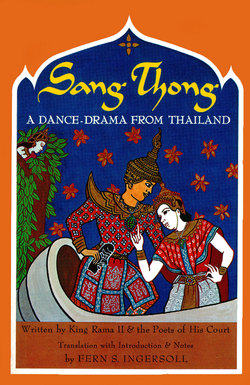Читать книгу Sang-Thong A Dance-Drama from Thailand - King Rama II - Страница 10
На сайте Литреса книга снята с продажи.
ОглавлениеAcknowledgments
Having tried to understand a drama embedded in a culture which is not my own, I owe debts of gratitude to many people who have guided me through an unfamiliar web of thoughts, feelings, and styles of expression. However, if I have at times become entangled in the web, it was through no fault of my patient guides.
I would like to thank Dean Rong Sayamanonda and M. L. Chirayu Navawongs, who made possible my studies of Thai literature at Chulalongkorn University, Bangkok. M. L. Chirayu directed me to Professor Vacharee Ramyanandand, who suggested Sang Thong as an expression of Thai views and values and then spent many hours helping me to understand it. Mrs. Buaphan Potaya and Mrs. Pratoom Ganjing also helped me with translation and explanations of ideas behind the words. Mrs. Maenmas Chavalit, head librarian of the National Library of Thailand, critically checked the translation of Act One and its explanatory notes, offering many perceptive interpretations.
For a varied insight into Thai culture, I am indebted to the late Phya Amman Rajadhon, who was my teacher for intermittent periods during the last fifteen years. Professor Visudh Busyakul made many of the Pali and Sanskrit sources of Thai literature meaningful to me. Later, at Catholic University, Dr. Siegfried A. Schulz offered suggestions helpful in further understanding Indian contributions to Sang Thong, and Dr. John Brown critically read the manuscript from the perspective of comparative literature.
Dr. Samrit Khunmuang brought me much of the information I have on Sang Thong in Laos, after appointments with knowledgeable Laotians were arranged by Mr. Louis Connick, representative of the Asia Foundation.
I would like to express my appreciation to Mr. Dhanit Yupho, retired director-general of the Fine Arts Department of Thailand, and to Mr. Montri Tramod, Miss Charuay Raksabhongsa, and Mrs. La-iad Herabataya of the School of Fine Arts for their explanations of the staging of Thai lakhon nok, and to Professor Khomkhai Nilprapassorn of Chulalongkorn University for her background information on the development of varied forms of Thai drama.
When the web of Thai culture has seemed particularly intricate, I have felt special gratitude toward Mrs. Somai Siphadung and numerous other Thais who kept Sang Thong, as it is loved by people in the Thai countryside, a real part of life for me. At these times my husband, Jasper Ingersoll, with whom I have long shared an interest in Thai views of the world, was constantly helpful with suggestions and critical comments.
I would also like to thank the publishers for permission to quote a passage from page 22 of Myth and Reality, by Mircea Eliade, translated by Willard R. Trask (New York: Harper and Row, 1963).
Finally, the encouragement of Mrs. Bonnie Crown of the Asia Society's Asian Literature Program has made possible this effort to understand something of Thai cultural character as it is expressed in this one delightful segment of its literary heritage.
